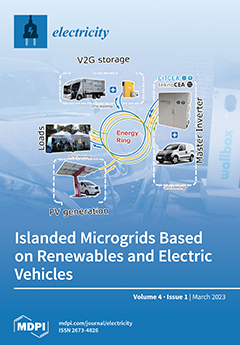Open AccessFeature PaperArticle
Live Field Validation of an Islanded Microgrid Based on Renewables and Electric Vehicles
by
Daniel Heredero-Peris, Cristian Chillón-Antón, Francesc Girbau-Llistuella, Paula González-Fontderubinat, Oriol Gomis-Bellmunt, Marc Pagès-Giménez, Antoni Sudrià-Andreu, Samuel Galceran-Arellano and Daniel Montesinos-Miracle
Viewed by 1970
Abstract
This paper presents a live field experience of creating an isolated microgrid for the Expoelectric fair during 2018 and 2019. The islanded microgrid comprises a Master Inverter with grid-forming capabilities and fault management. The Master Inverter and stationary batteries, and EVs with V2G
[...] Read more.
This paper presents a live field experience of creating an isolated microgrid for the Expoelectric fair during 2018 and 2019. The islanded microgrid comprises a Master Inverter with grid-forming capabilities and fault management. The Master Inverter and stationary batteries, and EVs with V2G capabilities provide storage. A PV generation system supplies the microgrid. The loads are the fair booths, mainly lighting and chargers for personal mobility vehicles. All the equipment used in the experimental microgrid is from different manufacturers. The operation and control of the islanded microgrid are based on the VDE-AR-N-4105 standard. The paper also presents the operation of the Master Inverter during faults. The live field experience shows that the proposed operation method is valid for operating different converters from different manufacturers without needing any communication layer between them. The experimental results also show that faults can be handled correctly by the Master Inverter to operate the entire microgrid safely. In conclusion, islanded microgrids based on power electronics are feasible to replace diesel generators in faires, conventions or temporary events.
Full article
►▼
Show Figures





